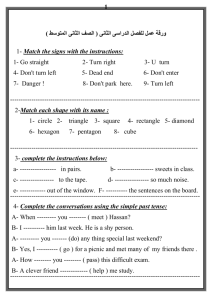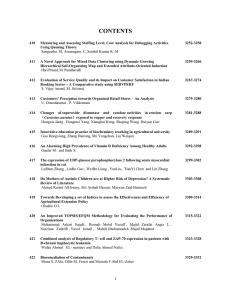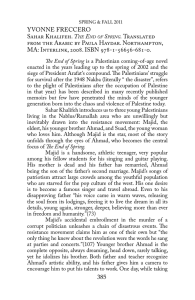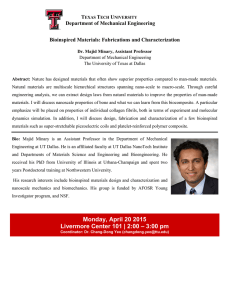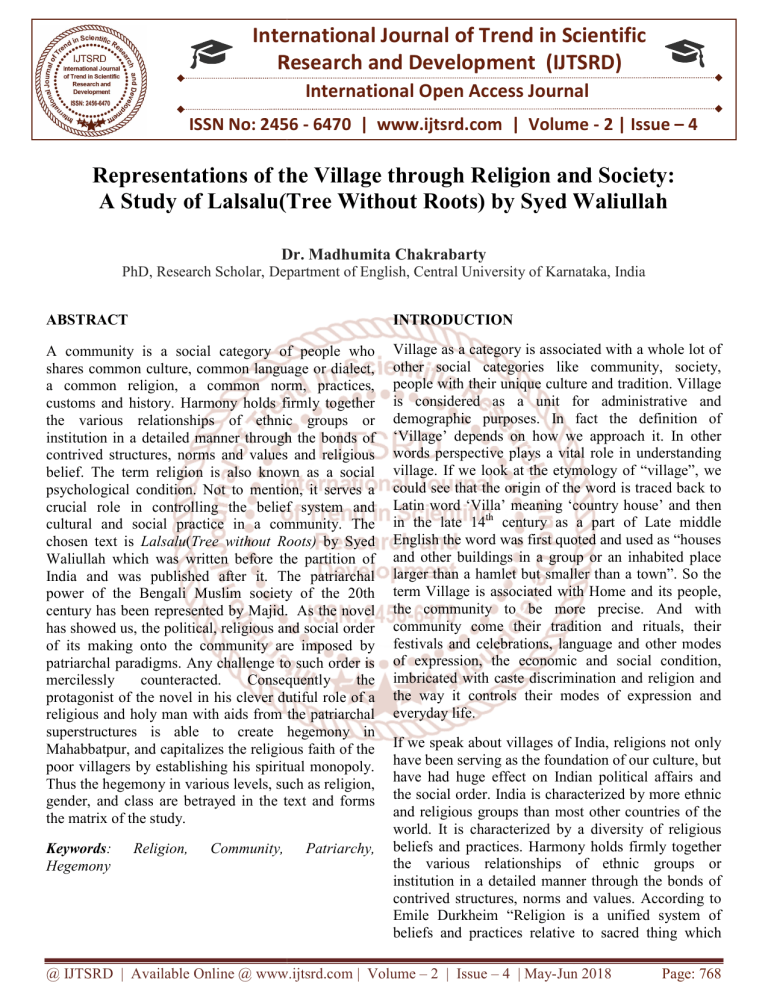
International Journal of Trend in Scientific
Research and Development (IJTSRD)
International Open Access Journal
ISSN No: 2456 - 6470 | www.ijtsrd.com | Volume - 2 | Issue – 4
Representations of the Villag
Villagee through Religion and Society:
A Study of Lalsalu(Tree Without Roots) by Syed Waliullah
Dr
Dr. Madhumita Chakrabarty
PhD, Research Scholar, Department of English, Central University of Karnataka, India
I
ABSTRACT
INTRODUCTION
A community is a social category of people who
shares common culture, common language or dialect,
a common religion, a common norm, practices,
customs and history. Harmony holds firmly together
the various relationships of ethnic groups or
institution in a detailed manner through the bonds of
contrived structures, norms and values and religious
belief. The term religion is also known as a social
psychological condition. Not to mention, it serves a
crucial role in controlling the belief system and
cultural and
nd social practice in a community. The
chosen text is Lalsalu(Tree
Tree without Roots) by Syed
Waliullah which was written before the partition of
India and was published after it. The patriarchal
power of the Bengali Muslim society of the 20th
century has been represented by Majid. As the novel
has showed us, the political, religious and social order
of its making onto the community are imposed by
patriarchal paradigms. Any challenge to such order is
mercilessly
counteracted.
Consequently
the
protagonist of thee novel in his clever dutiful role of a
religious and holy man with aids from the patriarchal
superstructures is able to create hegemony in
Mahabbatpur, and capitalizes the religious faith of the
poor villagers by establishing his spiritual monopoly.
Thus the hegemony in various levels, such as religion,
gender, and class are betrayed in the text and forms
the matrix of the study.
Village as a category is associated with a whole lot of
other social categories like community, society,
people with their unique culture and tradition. Village
is considered as a unit for administrative and
demographic purposes. In fact the definition of
‘Village’ depends on how we approach it. In other
words perspective
ective plays a vital role in understanding
village. If we look at the etymology of “village”, we
could see that the origin of the word is traced back to
Latin word ‘Villa’ meaning ‘country house’ and then
in the late 14th century as a part of Late middle
English
nglish the word was first quoted and used as “houses
and other buildings in a group or an inhabited place
larger than a hamlet but smaller than a town”. So the
term Village is associated with Home and its people,
the community to be more precise. And with
community come their tradition and rituals, their
festivals and celebrations, language and other modes
of expression, the economic and social condition,
imbricated with caste discrimination and religion and
the way it controls their modes of expression and
everyday life.
Keywords::
Hegemony
Religion,
Community,
Patriarchy,
If we speak about villages of India, religions not only
have been serving as the foundation of our culture, but
have had huge effect on Indian political affairs and
the social order. India is characterized by more ethnic
and religious groups
ps than most other countries of the
world. It is characterized by a diversity of religious
beliefs and practices. Harmony holds firmly together
the various relationships of ethnic groups or
institution in a detailed manner through the bonds of
contrived structures,
ructures, norms and values. According to
Emile Durkheim “Religion is a unified system of
beliefs and practices relative to sacred thing which
@ IJTSRD | Available Online @ www.ijtsrd.com | Volume – 2 | Issue – 4 | May-Jun
Jun 2018
Page: 768
International Journal of Trend in Scientific Research and Development (IJTSRD) ISSN: 2456-6470
unite in to one single moral community.” However,
harmony and unity do not mean uniformity which
implies similarity; unity may be born out of similarity.
In Macionis John’s definition, “ethnos in the narrow
meaning of word in the most general form can be
defined as a historically formed community of the
people possessing common relatively stable, specific
features of culture as well being aware of their unity
and difference from their communities”. They also
have a realization of their own culture bond. India is
an ethnological museum. “M.N.Srinivas observes that
the unity of India is essentially a religious one. People
may worship different deities but the religious
scriptures – Puranas, Brahmanas, Epics and Vedas –
knit the numerous heterogeneous groups together into
one religious society and give them the sense that
their country is sacred. Religious aspect is one the
most important and influential in human social life.
But the point that is very much noticeable is that
religion is probably the most powerful instrument of
social control. Religion, based on the cultural needs of
men has added new dimensions to human life and
human development. When coming down to the
concept of religion in Indian rural society and its
practice, then it must be said that there are distinctions
in the ways and religious beliefs in the villages. . If
we are to reclassify the Indian traditions and the
complex model of Indo-Islamic formation then we
have to capture the nuances of Indian Islam and rework the paradigm of the ‘great’ and ‘little’ traditions.
For as Dipesh Chakrabarty says with regard to
Bengali literary Nationalist culture that emerged in
the Nineteenth Century and intensified in the wake of
Swadeshi Movement:
a sharper, stronger sense of a collective Muslim
identity and its close and direct bearings on the
cultural growth are matters of common concern
among the students of cultural studies of South Asian
Islam identity. The Bengal phenomenon does not,
however, reveal a uniform and unidirectional search
for an exclusive Islamic identity. The Bengal Muslim
search for a collective identity was clearly caught
between the two opposite pulls of a local geographical
Bengali culture and of an extra-territorial Islamic
ideology. Indeed, a close analysis of the MuslimBengali literature in the late Nineteenth and Early
Twentieth Century reveals, however, unmistakable
tensions and vacillations and even clear conflicts in
Bengal Muslim’s self-perceptions and self-statements,
uncertainties that one may also detect in the complex
and dissimilar patterns of modern Muslim conditions
in Bengal. It would be unrealistic though, to take the
issue of religion completely out of the equation.
Bengali Muslims have been trying to construct a
synthesis of their identity for over a hundred years
now. During the partition of 1947, when the East part
of Bengal became Bangladesh, they created an
identity on the premise of excluding “Hindu India” as
the other. They were Muslims then. Then came a time
when being Muslim was not enough to hold the
homogeneity of Pakistan. They found themselves
under yet another colonial rule. The dream of a free
Bengal, ‘Shonar Bangla’ Bangladesh was in the
making. Finally they broke free in 1971, this time
their identity was primarily constructed on the
premise of excluding “Muslim Pakistan” and thus
they became “secular Bangladesh”. The story is,
however, a continuing one.
“[There is] a fundamental problem in the history of
this modern Bengali nationality – the fact that this
nationalist construction of home is a Hindu home. It is
not that the Muslim did not share any of this language
. . . [but] Hindu nationalism had created a sense of
home that combined the sacred with the beautiful.
And even though, this sense of home embodies
notions of the sacred, it was not intolerant of Muslims
as such. The Muslim – that is, the non-Muslim league
Muslim, the Muslim who did not demand Pakistan –
had a place in it. But the home was still a Hindu
home; its sense of the sacred was constructed through
an idiom that was recognizably Hindu.”
The text that is chosen for this particular study is
Lalsalu(Tree Without Roots) by Syed Walliullah.
The case of Bengali-Muslims presents itself, in this
context, as being somewhat unique as it both conform
to and deviate from the general pattern of
development in south-Asian Islam. The emergence of
Theme of the Text in Reference
Before Syed Waliullah (1922-1971) Lalsalu (1948),
the history of novels of Bangladesh was not very
significant. Based on the novel Lalshalu (Tree without
Roots) written by Syed Waliullah and published in
1948, is perhaps the most significant novel about the
rural Muslim community of East Bengal
(Bangladesh). The brief storyline is;
In a remote agrarian village, suddenly a haggardlooking Mullah named Majid appears. He cleans up
an old dilapidated grave and by declaring it as the
shrine of a famous Pir (a holy man) begins to worship
it. The villagers, of course, have no clue who the holy
@ IJTSRD | Available Online @ www.ijtsrd.com | Volume – 2 | Issue – 4 | May-Jun 2018
Page: 769
International Journal of Trend in Scientific Research and Development (IJTSRD) ISSN: 2456-6470
man was, and though it is a hoax, gradually give in
and begin to believe in the myth. The mystery of the
grave, the red fabric spread over its oval shape, the
glowing candles and the Quranic chants that Majid
recites beside the grave; create such an aura in the
ambience that the villagers, mostly simple peasants,
completely succumb to Majid's spell. They start to
bring rice and money as offerings to the “holy shrine”.
The shrine, through all these years, supplies Majid not
only financial independence but psychological control
over the people as well. From a vagabond desperado,
he becomes a man well rooted in society. He marries
Rahima, a not-so-young but hard working peasant
woman who though robustly built, remains a docile
wife. But as Majid's wealth and power increase he
feels the need of a younger wife. He marries Jamila, a
teenage girl who has no fear either for the grave or for
Majid himself. Majid vulnerably stays smitten to his
youthful sexy wife and slowly loses his tranquillity
and the myth about the 'holy' grave becomes
threatened. Jamila, inadvertently, becomes the
nemesis for Majid. And Mother Nature, in the form of
a deluge, finally strikes as Majid oversteps the
boundary of humanity.
The Original Author and His Times
Syed Waliullah (August 15, 1922 – October 10,
1971) was a Bangladeshi novelist, short-story writer
and playwright. He was notable for his debut novel,
Lalsalu (translated in English with the title "Tree
Without Roots"). He was awarded Bangla Academy
Literary Award (1961), Ekushey Padak(1984) and
Bangladesh National Film for Best Story (2001).
Lalshalu was written before the partition of India and
was published after that historic event. Right before
the partition when there arose a high voice in favor of
an independent state for the Muslims, Waliullah was
trying to detect the falsity in pseudo-religious dogmas
and practices, which voiced against freethinking and
education. It is also worthy to mention that as the
settlement of Pakistan was on the basis of religious
rights, Lalshalu could not draw the attention of the
Bangla Muslim literature. Only after the second
edition of it in 1960 Lalshalu began to be popular. It
is possibly the most significant novel about the rural
Muslim community of East Bengal (Bangladesh).
Tree Without Roots, actually a transcreation by
Waliullah himself which has been pleasingly accepted
as “enhanced version” or a more mature work of the
author was written in English nineteen years after the
Bangla version Lalsalu. Syed Waliullah, being a part
of the post-war intellectual commune, instills the
theory of existentialist view as well as futuristic
elements in his writing. He coalesce existentialist
approach of meaninglessness of a human existence
and the modernistic idea of self-consciousness side by
side. He neither endorses a sense of total rebuff of
existence nor gives a hope either. Instead he chooses
to hang about in between two ambiguities. In a way,
the novel combines elements of both modernism and
existentialism.
Deconstruction of the Novel and the Relevance of
the Study
In Lalshalu, Syed Waliullah has portrayed the
traditional superstitious Muslim society of Bangla
through the story of Majid and the ancient tomb
covered with a lal (red) shalu (cotton fabric). Majid,
an outsider of the village Mohabbatpur, arrives one
day and announces that the uncared-for tomb is of a
great priest of high honor which causes a sort of fear
among the populace of the village and thus taking
after the responsibility of looking after the tomb,
Majid begins his establishment for livelihood.
Whenever there appears any sign of obstruction on the
way of Majid’s existence, he creates a circle of fear to
mitigate the village people. Sometimes his existence
is endangered from his own conscience also.
The patriarchal power of the Bengali Muslim society
of the 20th century has been represented by Majid.
As the novel has showed us, the political, religious
and social order of its making onto the community are
imposed by patriarchal paradigms. Any challenge to
such order is mercilessly counteracted. Consequently
the protagonist of the novel in his clever dutiful role
of a religious and holy man with aids from the
patriarchal superstructures is able to create hegemony
in Mahabbatpur, whereas his wives continue their
subalternity. After agreement, Majid marries twice:
first the widow, Rahima who is ‘wide hipped, strong
and beautiful’; and then, the young, lively and curious
one, Jamila. Rahima and Jamila invoke the memory of
the prophet’s two wives. . In the post-Hijri period of
his life the Prophet too married two women, viz.
Sawda and Ayesha: the elderly Sawda was suitable to
take care of the family and the younger Ayesha
remained under their care. Nonetheless, such
parallelism appears only to be the novelist’s motif to
highlight his analysis of the political context in which
religion was being used to force a division on people
who were otherwise not bothered by differences. The
@ IJTSRD | Available Online @ www.ijtsrd.com | Volume – 2 | Issue – 4 | May-Jun 2018
Page: 770
International Journal of Trend in Scientific Research and Development (IJTSRD) ISSN: 2456-6470
agenda of re-appropriating the existing patriarchal
religious hegemony to launch a counter-offensive,
exemplifying competitive patriarchy is represented by
Majid’s intention of offering ‘divine’ service to this
community. Thereafter, Mahabbatpur becomes a site
of contesting patriarchal practices where them, first
pushed already to the corner and afterwards
marginalized, are not allowed to speak but only to be
spoken for or be represented by.
In the name of religious belief, Majid has tried to grab
whatever he needs. From financial assurance, he once
upon a time proceeds to satiate his subconscious
desire also. As a result, Rahima comes in his house as
his wife but after some years he feels that the single
wife is not enough for him. He begins to visualize the
physical features of Hasunir Ma who helps Rahima in
her household chores or of the wife of Byapari. As a
consequence we get the arrival of Jamila as Majid’s
second wife. When most of the people of the village
fail to earn the minimal livelihood, no sort of want
can touch Majid. From every effort of him, he only
ensures about it very intentionally.
Women, however, remain irrelevant in this
debate. Notably, this incident takes place to diffuse
the tragic overtone of the forced divorce between
Khalek Byapari, the richest man in the village and his
first wife Amina for her alleged ‘infertility.’ In reality
Majid had started to yearn for her and so he
manipulated this divorce solely based on his voluntary
verdict. Majid declared her as ‘fallen’ and therefore
unfit as Byapari’s wife. Amina was forced to leave
her own family. This event caused instigation in
several cases where the husbands on grounds of
suspected ‘chastity deserted their supposedly
‘infertile’ wives. These manipulations were
implemented amidst formidable silence and with
calculated precision. Majid as a self-proclaimed
religious leader had imposed certain codes of conduct
onto the community. Yet, his second wife, Jamila
seriously confronts this order and threatens Majid so
much that she is physically stifled and left to die.
Nevertheless even in her death she threatens Majid’s
authority - the feet of her dead body was perched
vandalizing the sanctum sanctorum of Majid’s place
of worship. Patriarchal violence seems to be at a loss
and somewhat embarrassed when confronted with
such silent yet visible defiance.
The fear that Majid created since his emergence in the
village continues till the end of the novel. Whenever
Majid feels necessity, he sharpens that sword of fear
creating different spells. Regarding the traditional
practices and beliefs of the villagers, Majid preaches
of his own keeping pace with the holy books. The
incident in which Maid compelled an elderly boy and
his father to be circumcised contributes hugely in
Majid’s enterprise. Convincing Byapari to divorce his
first wife Amina Bibi and compelling him it do it;
Majid matures his own plans only. When Akhas Ali
tries to set up a school in the village, Majid bravely
meets the challenge and establishes his opinion that a
mosque is far more essential. Two cases that make
him perplexed are the arrival of Peer Shahib in a
neighboring village and the apparently anti-religious
behavior of Jamila. Due to the appearance of the Peer
Shahib Majid falls in a sort of footless situation which
instigates him to tackle the perilous situation at a great
risk. For that turn Majid survives but what does he do
regarding Jamila?
At first Jamila seemed to Majid a soft lump though
from Jamila’s part he was not the same because on the
day before marriage Majid goes to have a look at his
would-be-wife, he seemed as the father of the future
groom to Jamila. Moreover, the days he comes to his
house, Rahima seems to her as the mother of the
groom. Through these humorous references,
Waliullah has depicted the tragedy of Muslim Bangla.
After some days of the marriage, Majid discovers that
Jamila is not that much submissive, she does not
possess any fear in the name of religion; she is
stubborn and does whatever she considers better; she
denies all the shackles that Majid wants to give her.
To exhort his influence on her, one night he locks her
in the tomb-shade. The night becomes stormy, as
there is storm is Majid’s own soul. After the storm
when he opens the entrance of the tomb-shade, he
discovers the unconscious body of Jamila, lying flat
on back, having no cloths on her chest; and touching
the tomb with her feet.
Subsequently, Mahabbatpur turns out to be a place of
disputed patriarchal exercises.
The design of the fiction has been captured in period
of time in East Bengal right after the Independence of
India and the partition of undivided Bengal which is
going through social changes and modernization.
Majid is the representative of the patriarchal order of
the pre-colonial society whereas Akkas Ali is the
agent of the postcolonial society endowed with
modern education, and urban polish. Their interests
collide around the dispute over the contradictory
proposal to build a mosque for the spiritual
@ IJTSRD | Available Online @ www.ijtsrd.com | Volume – 2 | Issue – 4 | May-Jun 2018
Page: 771
International Journal of Trend in Scientific Research and Development (IJTSRD) ISSN: 2456-6470
upgradation in Mahabbatpur and a secular English
school (though there were two maqtab10). Majid
obtains better support among the villagers in favor of
a mosque and defeats Akkas on basis of faith and
religious sentiment.
Majid was often portrayed as a modern-hero by
Waliullah. He has got the mental conflict, the
consciousness and the existential crisis of a modern
man. He earns the reader’s sympathy even though he
is a fake religious guru. After he has been long
fighting from his childhood with paucity, starvation
and uncertainty, he arrives at Mahabbatpur. He never
had any home of his own. He has always dreamt of a
home, wife and economic stability. But his fate before
here never supported him to have a smooth and welloff life. Majid is not a bizarre hero instead, a person
who uses religious superstition to stretch his roots
among the ordinary villagers. Slowly he becomes
powerful, authoritative, prominent and controlling. He
does not only have the benefit of financial steadiness
but also takes pleasure of being authoritative and
apparently reliable. This new taste makes him the
slave of his self-created sham identity. His divergence
as a modern man is representative of the social
conflicts which is going through transition of social
order and the new rootless existence which is the gift
of modernization and so called development of the
post Independent and post colonial timeframe which
has been captured by Waliullah.
Lalshalu was composed before the partition of India
and was in print after that historic event. Right before
the partition when there arose a high voice in favor of
an independent state for the Muslims, Waliullah was
trying to detect the falsity in pseudo-religious dogmas
and practices, which voiced against freethinking and
education. Lalshalu has become a true picturization of
the agrarian Muslim society. From this novel the early
superstitious scenario of a Muslim Bangla village
could be visualized.
In the English version, now generally believed to be
by Syed Waliullah himself, Majeed acquires certain
grandeur at the end, returning alone to the mazar in
the midst of raging flood waters. A picture of rural
Bangladesh in the early forties, Tree without Roots
also provides a picture of eternal Bangladesh subject
to the ravages of nature, of storms and floods, of
cyclones and dying rivers.
Waliullah has created a fictional village Mahabbatpur,
as the theatre for the doings of the fortune-hunting
Majeed who has transformed into a shrine the hitherto
neglected grave of an unknown person about whose
identity he knows nothing but whom he declares to be
a saint that has visited Majeed in a dream. The village
is almost mythical; it is without connection with the
world outside; Life here is elemental. Majeed is a
veritable colonialist and an active missionary, two
rolled into one. He plants fear into the hearts of the
innocent peasants, makes them feel guilty for their
neglect of the patron saint. He becomes the ruler and
seeks to transform the simple peasants, almost pagans
in their lifestyle, into devout Muslims. But in spite of
all this the author does not make him the villain of the
piece, He is as lonely as the shrine he has created and
with time he himself has become the slave of his own
creation. He is nostalgic; he feels for his childhood
home which he has left and tries to strike roots in a
land where he has never been before. Having no
sharer of his secrets he often resorts to memory and
recollections of his past days and past life where he
was nobody, a victim of poverty and misfortune. And
how he preyed upon the simple rural folk by
exploiting religion, becoming the self-appointed
guardian of a mazar which he claims is that of a saint.
Majeed could leave his shrine for his safety but he did
not because his identity has no meaning without the
shrine. He mingles his past and present, his happiness
and sadness, he is a modern character:
That wilderness day when I first came to this village
how hungry I was! I used to have nothing that time,
neither owned any land, home, nor wife and cattle.
And now I am the protector of the mazar. I get money,
I reside contentedly, and I demand the people’s
admiration. Of course I have changed but, thanks be
to God, for the better. I have no cause to be sad
(Waliullah 76).
Now, it is not only his material subsistence but also
his values, belief-system that have to to live on.
Nevertheless he is deeply conscious of the fact that
the mazar is a sham and pointless entity, he seizes this
purposelessness which can only make his future
existence significant. Alternatively, it is Majid’s
image and personality which insists his realization to
build a significance and worth which can sustain his
mature and continued survival in Mahabbatpur. It is
his survival which comes first of all, even his ethics.
Even he tells to himself: “If, I make a living, at the
same time, is there something immoral in that? After
all one must live. And I live to spread the word of
God” (waliullah 12). Seen in that way, Majeed is a
representative of coarse deprived pitiable Bangladeshi
@ IJTSRD | Available Online @ www.ijtsrd.com | Volume – 2 | Issue – 4 | May-Jun 2018
Page: 772
International Journal of Trend in Scientific Research and Development (IJTSRD) ISSN: 2456-6470
country people who hunt for their existence in selfconstructed sacred identity. As a substitute of their
ruthless poverty, they must exist but for the survival
they need to have some kind of ethics to embrace or
to turn their life consequential. In the words of the
narrator of the novel:
controlling. He does not only takes pleasure in
financial steadiness but also enjoys being reliable.
This new experience makes him the slave of his selfcrafted fraud character that he constructed for himself.
His reappearance is a pick of giving in towards his
own dignity.
Perhaps the reason there are so many white tupees in
this part of the world is that the land cannot feed the
men. Little food means more religion. God said: cover
your heads when you pray to me, for this is the mark
of the god-fearing man. . . There are more tupees
than heads of cattle, more tupees than sheaves of rice
(Waliullah 5).
CONCLUSION
It is also somewhere true that the past memories of
Majeed does not give him pleasure, they are mostly
the source of fear. He is afraid of his past or rather
going to back to the Past. Incident explains that he has
robustly resolute to go back in his shrine “at the cost
of his own demolition even” (Waliullah 135). Majeed
proves himself as his own master by applying his own
subjective choice. Actually, he does not have any
identity without the shrine. Maybe the shrine is a
sham but it is the only point to continue his life.
Though, Majeed knows that his return may bring his
life at risk, he decides to uphold his value or essence
as his identity will not have any meaning (here value
or power) without his essence. As a result his
existence at a definite end of life without his worth
(essence) is also futile. An unease or fright of being
defeated his core or belief is the cause behind this. As
an alternative to any Pir, it is flood or natural calamity
that brings worry back inside Majeed to smash his
self-constructed worth:
“It is tricky for one to know whether one has sinned,
and to what degree, Majeed told himself. Except I do
identify that I am not terrified for the reason of my
misdeeds. My fright is of having to return to where I
began” (Waliullah, 134).
Most likely it is the motive why Majeed chooses to
put his life at jeopardy with the optimism of retaining
all his material accomplishment he has achieved in
Mahabbatpur. Perhaps he doubts his past poor
powerless life. Now he knows that both of his past
and present lives are meaningless but with he has
chosen his present life as more important. Having said
that it is equally true Majeed is not an absurd hero but
a person who uses religious superstition to extend his
sources amidst the ordinary village dwellers. Slowly
he turns out to be prominent, authoritative and
Literary imagination plays a vital role in a process of
recovery where Hindus and/or Muslims attempt to
map the contours of the mutilated land in a bid to
create a site of belonging, habitation and memory
while changing the dynamics of fiction, particularly
the form and content of the novel in Bangla that has
responded to 1947 and afterwards in heterogeneous
ways. When the recent partition destroyed a sense of
belonging to the land, these texts offered a renewed
sense of place that contributed to the processes of
decolonization and reinstated the ‘human subject’ at a
time when it was most dehumanized. As Lacan (and
Freud before him) has reminded people, the event of
trauma, by its very ambiguous nature, recedes to the
background while fantasies based on it overpower
individual and collective psyches. This literary piece
forms a testimonial or memory-text that deals with
the construction of the Muslim subjectivities in times
of the partition of Bengal and right after that and the
questions around religion, faith, the belief-system , the
complex collaboration of poverty and religion
especially the lower caste, the rural community. Texts
that deals with these wide ranging issues, written over
a long period of time, try to reconstruct the lives of
individuals and communities, marginal or elite, whose
memories of trauma and displacement had dissociated
them from their own life stories. The less visible and
delayed effects of displacement and violence are seen
in the family and community spaces that these texts
foreground. They give an added dimension to a set of
micro-events, often unspeakable, within the partition
and lay bare the processes of how literature
transforms the actual into the apocryphal and the
mythical.
On one hand, the text has recognized and documented
conflicts and identity crisis to see the importance of
personal memory to demonstrate the plurality of how
one remembers the incidents that causes the sociocultural change (or how one forgets it) even within the
similar commune just as they display that gender,
class and caste variegate the recollections of a
community since the communities in turn suffers a
process of self-fashioning at definite moments in their
@ IJTSRD | Available Online @ www.ijtsrd.com | Volume – 2 | Issue – 4 | May-Jun 2018
Page: 773
International Journal of Trend in Scientific Research and Development (IJTSRD) ISSN: 2456-6470
history. A call for new resources for remembering and
representing these incidents means that social
relations, locality as well as memory that makes up
subjectivity. Thus, one needs to investigate how both
the ideological force of the present/past relationship
as well as the tension with which the author, reader
and text are held together as historical variables have
produced the cultural and memory-texts in the region.
The novel is significant, not for the reason that it
signifies someone’s destiny to us, possibly
moralistically, but because this outsider’s luck by
virtue of the flare which devours it yield us the
warmth which we never draw from our fate.
Finally, the word ‘Lalsalu’ means ‘red cloth’ which
generally is used on a religious shrine. This title in
Bengali itself serves as a symbol of religious impact
on the narrative. In fact, it is known that the novel in
Bengali was inspired by a shrine covered with red
cloth that he would often pass when he lived with his
father in Mymensingh (presently in Bangladesh).
Although, the English translated version of the text
does not retain the same title, it reflects the same
storyline employing the ‘shrine’ as a significant motif
that is used in the whole narrative. It becomes the
symbol which represents the religion and its
overwhelming influence into the minds of the simple
rustic people. It also stands out as a symbol of power
which was acquired by Majid in order to dictate the
commoners in Mahabbatpur. Needless to say, the
same motif served as an instrument of fear exploited
by the name of religion or religious faith by Majid to
control their lives and ensure his survival in the
village.
6. Kohli, Atul. The State and Poverty in India: The
Politics of Reform, Cambridge: Cambridge
University Press,1987
7. Rigg, Jonathan, “Redefining the Village and Rural
Life: Lessons from South-East Asia” (Source: The
Geographical Journal). 1994 : The Royal
Geographical Society, Vol. 160
8. Patel, Sujata, “The Nostalgia for the Village: M.N.
Srinivas and the Making of Indian Social
Anthropology”.
Journal
of
south-Asian
Studies,1998
9. Dasgupta, Biplab, “Urbanization and Rural
Change in West Bengal.” February 14: Economic
and Political Weekly,1987
10. Park, Robert E. Human Communities, New York:
Free Press, 1952:p.l6.
11. Breman, J. The Scattered Image: Construction
and De-construction of the Village in Colonial
Asia. Amsterdam, Comparative Asian Studies,
1987 --- The Village in Asia Revisited. Delhi,
Oxford UP, 1997
12. DeVotta, Neil. “The Utilisation of ReligioLinguistic Identities by the Bengalis: Towards
General Explanation.” Commonwealth and
Comparative Politics 39 (2001): 65-95.
REFERENCES
1. Waliullah, Syed, Tree Without Roots. 2006,
Calcutta: Ubs Publisher’s
2. Bose, N.K. The Structure of Hindu Society, New
Delhi: Orient Longman.1975
3. Srinivas, M.N. Village India, Chicago, Chicago
University Press, 1967: pp 1-35; M.N Srinivas.
The Remembered Village, Delhi, Oxford
University Press,1976
4. Dubey, S.C. "The Indian Village: A Symposium",
Journal of Asian Studies, vol.16, New York: AMS
Press, 1956-57: pp.19-30.
5. Inden ,Ronald B.Imagining India, Oxford: Basil
Blackwell, 1990
@ IJTSRD | Available Online @ www.ijtsrd.com | Volume – 2 | Issue – 4 | May-Jun 2018
Page: 774


